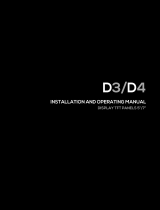
EWRC 300/500 NT - Contents
6. FUNCTIONS AND REGULATORS ................................................................ 26
6.1. SETTINGS ........................................................................................................................ 26
6.1.1. PROBE SETTING AND CALIBRATION ............................................................................................................................26
6.1.2. DISPLAY SETTINGS ...........................................................................................................................................................26
6.2. FUNCTIONS ..................................................................................................................... 27
6.2.1. UPLOAD, DOWNLOAD, FORMAT ...................................................................................................................................27
6.2.2. MULTI FUNCTION KEY .....................................................................................................................................................28
6.2.3. UNICARD ............................................................................................................................................................................28
6.3. BOOT LOADER FIRMWARE .............................................................................................. 29
6.4. COMPRESSOR ................................................................................................................. 30
6.4.1. COMPRESSOR CONFIGURATION ..................................................................................................................................30
6.4.2. SECOND COMPRESSOR CONFIGURATION .................................................................................................................30
6.4.3. COMPRESSOR OPERATING CONDITIONS ...................................................................................................................30
6.5. COMPRESSOR/GENERAL PROTECTIONS ........................................................................ 31
6.5.1. COMPRESSOR SAFETY TIMINGS ....................................................................................................................................32
6.6. DEFROST/DRIPPING ........................................................................................................ 33
6.6.1. DEFROST TYPE AND ACTIVATION .................................................................................................................................33
6.6.2. AUTOMATIC DEFROSTING .............................................................................................................................................34
6.6.3. MANUAL DEFROST ...........................................................................................................................................................34
6.6.4. EXTERNAL DEFROST ........................................................................................................................................................35
6.7. DEFROST MODE .............................................................................................................. 36
6.7.1. DEFROST WITH ELECTRIC HEATERS .............................................................................................................................36
6.7.2. INVERSE DEFROST ............................................................................................................................................................37
6.7.3. DOUBLE EVAPORATOR DEFROST .................................................................................................................................38
6.8. EVAPORATOR FANS ......................................................................................................... 40
6.8.1. EVAPORATOR FAN OPERATING CONDITIONS ...........................................................................................................40
6.8.2. FAN OPERATION IN THERMOREGULATION MODE ...................................................................................................41
6.8.3. FAN OPERATION IN DUTY CYCLE MODE .....................................................................................................................41
6.8.4. FAN OPERATION IN DEFROST ........................................................................................................................................42
6.8.4.1 Fan operation without probe 42
6.8.5. FAN FUNCTION DURING DRIPPING ..............................................................................................................................43
6.8.6. POST-VENTILATION ..........................................................................................................................................................43
6.9. DEEP COOLING CYCLE - DCC .......................................................................................... 44
6.10. PREHEAT ........................................................................................................................ 44
6.11. PRESSURE SWITCH ........................................................................................................ 45
6.11.1. AUXILIARY OUTPUT (AUX/LIGHT) ................................................................................................................................46
6.12. DOOR/EXTERNAL ALARM MANAGEMENT ................................................................... 47
6.13. DEMISTING HEATERS (FRAME HEATERS)...................................................................... 49
6.14. CONDENSER FANS ........................................................................................................ 50
6.15. STAND-BY ...................................................................................................................... 51
6.16. PUMP DOWN ................................................................................................................. 51
6.16.1. SERVICE STOPPAGE .......................................................................................................................................................51




















